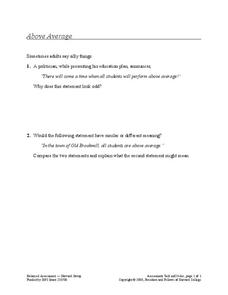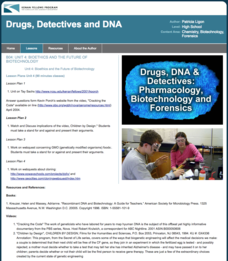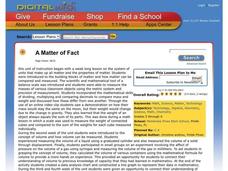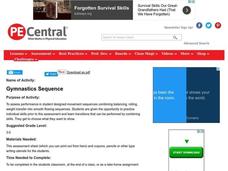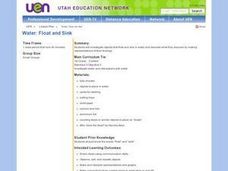Balanced Assessment
Above Average
Raise the bar and strive to be above average. The assessment task requires budding mathematicians to think critically and evaluate given statements. What does it truly mean to be above average?
Balanced Assessment
Dot Patterns
Use geometric patterns to teach your class how to write functions. The assessment task has scholars consider a pattern of dots to draw the next picture of the pattern. Pupils then analyze the pattern, which helps them develop a function...
Wind Wise Education
What Causes Wind?
Through watching several classic air pressure demonstrations, middle schoolers determine that high pressure areas move toward lower pressure areas, heated air causes a drop in pressure, and forces exist when pressures are unequal....
Science Matters
Earthquake Building/Shaking Contest
Japan is one of only a handful of countries that constructs buildings that are almost earthquake proof. The 13th lesson in the 20-part series challenges scholars to build structures to test against earthquakes. With limited materials and...
CK-12 Foundation
Work and Force: Lifting a Bucket
How much work does it take to lift a bucket? An interactive presents a problem of lifting a bucket from the ground to the top of a building. Using their knowledge about work and integrals, pupils calculate the amount of work required to...
US Institute of Peace
Maintaining Trusting Relationships
What role does trust play in diffusing a tense situation? Young social scientists explore trust on a personal and global level during a lesson on peace and conflict. After participating in a trust sit, participants work in groups to...
Kenan Fellows
Unit 1: Introduction to Biotechnology
Biotechnology is big! Introduce the uses of biotechnology to science scholars with a fascinating, fact-filled unit. The first installment in a series of four biotechnology units covers the role biotechnology plays in human and...
Kenan Fellows
Unit 4: Bioethics and the Future of Biotechnology
What's the future of biotechnology? Explore a hot topic in the fourth and final unit in a series of Biotechnology lessons. Learners develop an understanding of the many issues in bioethics, then create an argument for or against the role...
Serendip
Where Does a Plant's Mass Come From?
Where does the mass for a growing tree come from? Scholars consider a few different hypotheses and guess which is correct. They then analyze data from different experiments to understand which concepts science supports.
Physics Classroom
Energy Ranking Tasks
Here's an interactive with real potential ... potential energy, that is! Scholars analyze scenarios, then rank objects in order of greatest to least kinetic energy, potential energy, and speed. The interactive provides support materials,...
Purdue University
Take a Stand!
Not all will still be standing by the end! Challenge classes to use engineering principles to design display cases with specific constraints. A hands-on STEM lesson reviews the concepts of tension, compression, and torque before...
Purdue University
Recycling Paper
Build an appreciation for the green movement by recycling your own paper! Learners participate in a STEM instructional activity by learning about the process of recycling paper and then designing their own models. Their ultimate task is...
Radford University
Fuel Efficient Function Activity
Pupils research the five most fuel efficient vehicles of the same type and come up with a way to display the mile per gallon for each vehicle. After choosing a vehicle, scholars create graphs to display miles traveled given the amount of...
PBS
Bogged Down
Enjoy a hands-on lesson that will certainly hold water with your classes. Young scientists design an experiment to determine the materials that absorb water the best. They test both man-made and nature-made materials and conduct...
Curated OER
Truth in packaging
In this packaging worksheet, students complete a chart where they weigh packages and compare it to the label on the package. Students complete the chart for 5 packages and answer 3 questions.
Curated OER
A Matter of Fact
Young scholars design their own Science experiment. For this science experiment lesson students create a hypothesis related to matter and test it. They displayed their data in a graph.
Curated OER
Measure Up- How Many Pounds in All?
In this adding pounds activity, 1st graders complete 6 problems. They use the picture bank at the top of the page that shows the weight of 6 objects in pounds. They look at the pictures in each problem and match them to their weight...
Curated OER
Gymnastics Sequence
Students perform a sequence of combined movement skills. They make smooth transitions from one movement to the next and choose the sequence they would like to exhibit.
Curated OER
Making Impact Craters
Students examine images of Moon craters and speculate about what caused them. They create craters using sand weighted balls. Students measure crater sizes and draw ejection patterns to see what effect size, weight, and velocity have on...
Curated OER
Place Value Balancing Act
In this place value balancing act worksheet, 1st graders cut out the unit weights (100, 10, 1) and put them on four scales to make them balance with the weights given.
Curated OER
Sampling Rocks
Students study about sampling through an investigation of rocks found in the schoolyard. They sort the collected rocks by characteristics such as size, weight, and color, to see if any generalizations can be made about the types of rocks...
Curated OER
Butterflies And Lady Bugs
Students engage in a variety of fun art activities about butterflies and lady bugs. Eric Carle's books are used as an opener for the lessons. They make t-shirts, sandwiches and a lady bug paper weight.
Curated OER
Water: Float and Sink
First graders work in small groups to observe the tendency to float or sink for a variety of objects in water. They sort the objects and discuss their observations. They use aluminum foil to construct a boat and test it for weight capacity.
Curated OER
Dive Right In
Students make a submarine from a two liter bottle to observe the effects of increased water pressure in deeper water. They discover that water has weight and can cause objects to submerge.
Other popular searches
- Mass and Weight
- Applied Math Weight
- Measuring Weight
- Weight Training
- Algebra 1 Weighted Averages
- Estimate Measure Weight
- Weight Lifting
- Customary Units of Weight
- Weight Measurement
- Weighted Average
- Customary Measurement Weight
- Weight Loss
